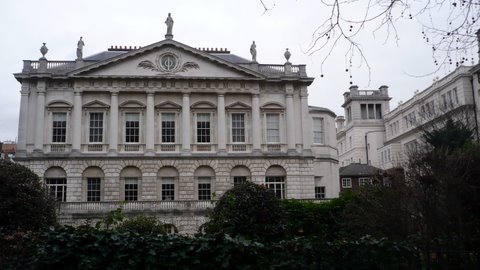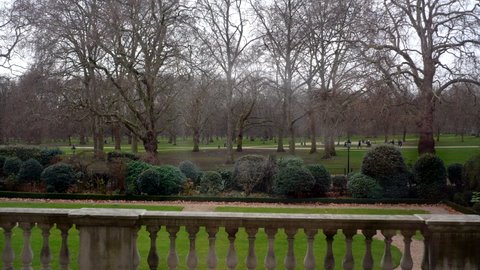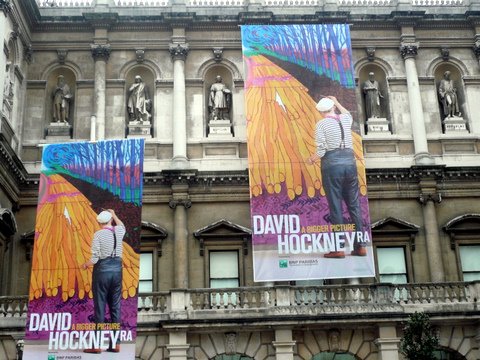Visit Reports
Visit to Spencer House and the David Hockney Exhibition at the Royal Academy 23rd January 2012

Spencer House
The story of Spencer House begins in 1755 with the secret marriage at Althorp between the 21 year old John, First Earl Spencer,
great grandson of Sarah Jennings, Duchess of Marlborough, and Georgiana Poyntz. Georgiana was 18, beautiful, and, unusually for
the times, this was a love match. John had inherited great wealth along with the title, and a year later they decided to build
a magnificent London house overlooking Green Park, where they could entertain on a lavish scale and display their art collection
as well as John’s Grand Tour purchases. On its completion in 1766 Spencer House was regarded as one of the most beautiful private
houses ever built in London.
John Vardy designed an elegant classical house, inspired by Imperial Rome, and the ground floor rooms included the magnificent Palm
Room with its gilded arched fronds. In 1758 Lord Spencer employed the architect James ‘Athenian’ Stuart to complete the first floor.
He introduced a Greek style into his design. His masterpiece was the Painted Room, much of which he painted himself. All this detail
is but a small sample of the lively anecdotes and historical information with which our two outstanding guides enriched our HEDFAS
members’ tour when we visited Spencer House on 23rd January 2012.

We heard that the house was used by the Spencer family until the 1930s. When war broke out most of the treasures were removed
to Althorp, which was fortunate as the house suffered bomb damage on more than one occasion, particularly to The Painted Room. After the
war the house was leased as office accommodation to various companies, and eventually acquired by Lord Rothschild’s Trust. He decided
that the State Rooms should be restored to their 18th century splendour with the addition of modern heating and services. All these rooms
can now be hired, at a price, for weddings and private functions! Some of the original art and furniture has been returned; some has been
loaned from The Royal Collection and the V & A; and some has been recreated or purchased. The result is ‘London’s finest surviving 18th
century Town House’ and it was a real pleasure to be shown round it.
The Royal Academy - David Hockney Exhibition

The afternoon visit to the David Hockney Exhibition at the Royal Academy could not have been a greater contrast. This showing of 150 landscapes spanning 50 years of Hockney’s work makes a huge impact. After all the media coverage of the event, it was exciting to be there during the first week of public opening. There was a buzz of anticipation in the gallery. It was busy but, as Hockney had been given the use of all the galleries on the floor, there was ample space to view the work.
Since returning from California Hockney had become inspired with the countryside and nature around the East Yorkshire wolds of his early life, and the majority of the exhibits are recent works. The output for a man in his 70s is extraordinary. He has chosen particular locations such as a point on a farm track, a viewpoint in Woldgate Woods or a tunnel of trees and studied them closely through the seasons and different lights and then painted them at some speed. The colours are vivid and displaying them in groups in separate galleries maximises the impact. There are 36 beautiful watercolours of Midsummer in East Yorkshire painted in 2004 as well as charcoal drawings.
Hockney has been innovative in embracing new technology demonstrated with the ‘Arrival of Spring in Woldgate’ series of iPad drawings. These studies made from 1st January to 2nd June, often from the same viewpoint of a tree stump beside a lane near Bridlington, depict the natural changes in season, colour and mood. Even more recently he has created the atmospheric Yosemite series from iPad drawings made in October 2011.
David Hockney has also experimented with film, attaching 9 cameras to his jeep and driving very slowly down a country lane recording the changing seasons. The combined results are shown together on a screen like a panoramic collage which has the effect of placing the viewer right inside the camera.
Walking through the galleries surrounded by, at times, immense canvases, it was like being in Woldgate Wood and the colour was
exhilarating. The images of a great day will have left a lasting impression on all those lucky enough to take part in this visit.
Carole Sugden (Photographs by Maureen Welsh and Diana Diggines) January 2012
